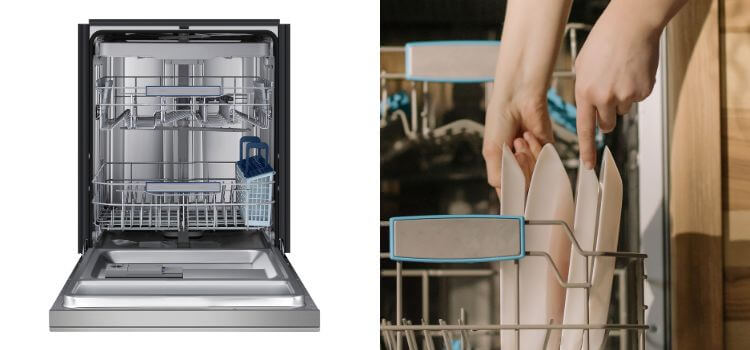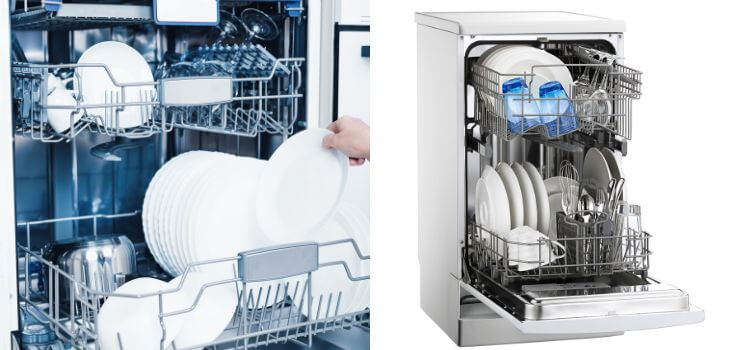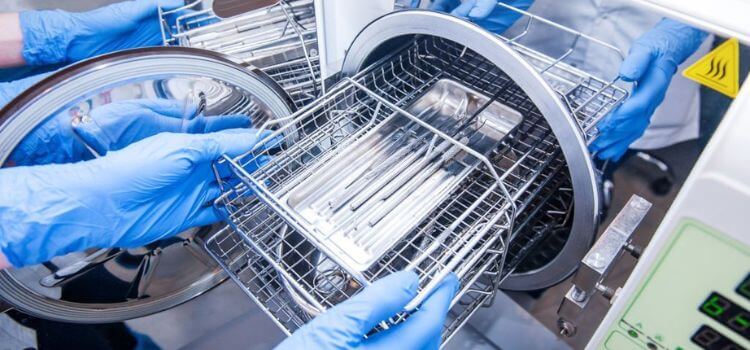As an Amazon Associate, I earn from qualifying purchases
In kitchen appliances, two giants stand tall with their dishwashing marvels: KitchenAid and Samsung. Both brands, acclaimed for their dedication to innovation and craftsmanship, have gifted homeowners with efficient, high-quality dishwashers. But which offers the ideal blend of performance, efficiency, and advanced features? As we delve deep into this comparison, we’ll uncover the nuances that distinguish these two powerhouse brands.

Brief History of KitchenAid Dishwashers
KitchenAid, a brand synonymous with timeless design and unparalleled performance, made its initial foray into the kitchen appliance industry in the early 20th century. Originating as a humble stand mixer company, KitchenAid’s foray into the dishwasher segment was a testament to its commitment to making life easier in the kitchen.
By introducing features like ProScrub and ProDry, KitchenAid redefined the art of dishwashing. Their dishwashers, lauded for their sturdiness and meticulous cleaning, are often characterized by stainless steel finishes, robust wash cycles, and user-friendly interfaces. Over the decades, they’ve continued evolving, merging vintage aesthetics with state-of-the-art technology, making them a favorite among homeowners and chefs.
Introduction to Samsung’s Dishwashing Legacy
On the other side, we have Samsung, a technological titan at the forefront of innovation for decades. While globally recognized for their smartphones and televisions, Samsung’s ventures into home appliances have been revolutionary. Their dishwashers, introduced later than KitchenAid’s but with the weight of Samsung’s tech prowess behind them, boast futuristic features and intelligent capabilities.
With unique offerings like the WaterWall technology and Zone Booster, Samsung has set benchmarks for precision cleaning and energy conservation. Their designs, often sleek and contemporary, seamlessly integrate into modern kitchens, reflecting a blend of elegance and functionality.
Product Comparison

Performance and Efficiency Comparison
To make an informed decision about the best dishwasher, it’s paramount to understand how KitchenAid and Samsung dishwashers fare in terms of performance and efficiency.
Water and Energy Efficiency
Water and energy efficiency are critical parameters for assessing dishwashers in an era emphasizing sustainability. With its adaptive wash technology, KitchenAid ensures optimal water usage by adjusting the wash cycle based on load size and soil levels. Their models often meet the ENERGY STAR® certification, ensuring homeowners save on utility bills while minimizing environmental impact.
Samsung, not to be outdone, employs the Digital Inverter Motor in its dishwashers, enhancing energy efficiency and reducing noise levels. Their Half Load option, available in many models, allows users to run partial loads without compromising energy efficiency. Furthermore, Samsung’s AutoRelease Dry feature ensures optimal drying with minimal energy consumption.
Cleaning and Drying Capabilities
The primary function of a dishwasher is, unsurprisingly, cleaning. KitchenAid’s ProWash cycle stands out in this domain. This intuitive feature determines the ideal dish cycle and makes real-time adjustments to achieve impeccable cleaning results. Their Advanced ProDry system further ensures dishes emerge spotless and dry, leveraging heat and a fan to enhance drying performance.
With its WaterWall technology, Samsung offers a sweeping wall of water, ensuring every corner of the dishwasher is reached, leaving no dish uncleaned—their Zone Booster targets heavily soiled pots and pans, providing a concentrated wash where needed most. The AutoDoor Open feature in select models ensures dishes are perfectly dried, opening the door slightly after a cycle to let steam out and fresh air in.
Features and Technologies Breakdown
KitchenAid Exclusive Features
In the modern era, when high-tech kitchen gadgets have taken center stage, KitchenAid has been at the forefront, introducing exclusive features that genuinely make a difference. With a history that dates back over a century, KitchenAid’s dedication to innovation is shown in its range of products.
Flex Edge Beater: An enhancement to the standard beater reduces the need for frequent scraping, ensuring ingredients get mixed quickly and efficiently.
Precise Heat Mixing Bowl: Ideal for tempering chocolate, proofing dough, or keeping dishes warm, this is a game-changer for culinary enthusiasts.
Extended Range of Attachments: KitchenAid has many attachments, from pasta rollers to food grinders, that turn your stand mixer into a versatile kitchen tool.
Soft Start Feature: This feature ensures that the mixer starts at a slower speed, thus preventing ingredients from splattering out of the bowl.
Samsung Unique Technologies

Samsung, synonymous with groundbreaking technology, has been pioneering features in the kitchen appliance sector that have reshaped how we perceive culinary tasks.
Twin Cooling System: This feature, present in Samsung refrigerators, maintains optimal humidity levels, ensuring fresher and longer-lasting produce.
Intelligent Dial Control: A sleek, streamlined way to control your oven, the Smart Dial remembers your cooking habits and suggests favorite cooking combinations.
Convection Oven Technology: Ensuring even heat distribution, this technology guarantees that your dishes are cooked perfectly every time.
Integrated Wi-Fi and Voice Controls: Control your kitchen appliances remotely or use voice commands, a testament to Samsung’s dedication to smart home integration.
Design and Build Quality
The design and build quality is pivotal when it comes to lasting impressions. With their timeless design and robust build, KitchenAid’s iconic stand mixers have become a statement piece in kitchens worldwide. The metal construction promises durability, while its wide array of colors ensures it complements any kitchen décor.
Samsung, on the other hand, leans heavily on modern aesthetics. Sleek lines, intuitive touch controls, and high-quality materials such as tempered glass and stainless steel ensure their appliances aren’t just functional and a visual treat.
User Reviews and Satisfaction
User reviews offer an authentic window into product efficacy in an age dominated by digital conversations. Countless reviews praising its durability, performance, and after-sales service support KitchenAid’s long-standing reputation.
Samsung’s kitchen gadgets, renowned for their state-of-the-art features, also bag high satisfaction ratings. Users often highlight their innovative features, energy efficiency, and the seamless integration of intelligent technologies as key benefits.
Price Point Analysis
Value for money is a crucial consideration for consumers. KitchenAid’s products, though pricier, offer unmatched durability and a comprehensive warranty, ensuring a long-term investment.
With its wide range of products, Samsung caters to both budget-conscious and premium consumers. While their high-end models have a steeper price tag, the plethora of innovative features and cutting-edge technology justifies the cost.
Installation and Maintenance Insights
In the household appliances industry, understanding the intricate installation and maintenance details can be a defining factor in making an informed purchase decision. From measuring the space required to integrating your new appliance into the existing workflow of your home, we provide all the insights required for a smooth installation process.
Installation Guidelines
Whether you’re opting for a KitchenAid mixer or a Samsung refrigerator, the fundamental aspect lies in the product’s compatibility with your specific space and utility connections. We offer a comprehensive guide, detailed with every minute aspect, from unboxing to the final alignment.
Maintenance Considerations
Understanding the longevity of your investment is crucial. With regular cleaning schedules, lubricating essential parts, and periodic inspections for wear and tear, your appliance can serve you for years to come. The maintenance insights we provide ensure that the efficiency of your product is maintained without a significant investment in time or resources.
Environmental and Sustainability Aspects
The role of sustainable and environmentally responsible manufacturing is not only a moral duty but a significant selling point in the current market landscape. Here’s how both KitchenAid and Samsung are striving to meet these responsibilities.
KitchenAid’s Environmental Initiatives
KitchenAid’s approach towards sustainability revolves around energy-efficient designs and ethical sourcing of materials. Their long-lasting appliances contribute to less wastage and reduced carbon footprint.
Samsung’s Green Philosophy
Samsung has a comprehensive approach that incorporates eco-friendly practices in manufacturing and disposal. Their products often comply with top-tier energy-saving certifications, reflecting their commitment to global sustainability.
Warranty and Customer Support Evaluation
Your peace of mind when purchasing a significant household appliance is tied to the warranty and customer support available.
KitchenAid Warranty Insights
With KitchenAid, customers usually enjoy extended warranty options. They also provide comprehensive customer support, ensuring all your queries and concerns are addressed promptly.
Samsung Customer Support Overview
Samsung’s customer support is lauded for its multi-channel accessibility. The warranty options are tailored to different products, and the responsive support team ensures a seamless customer experience.
Customer Feedback & Reliability Insights
What Users Love About KitchenAid
KitchenAid’s appliances are celebrated for their robust build and performance consistency. Users frequently praise the brand for its aesthetic appeal and functionality, which often exceeds expectations.
Why Some Prefer Samsung Over KitchenAid
Samsung has won some customers’ preferences by offering innovative features and a sleek modern design. Their emphasis on integrating innovative technology into everyday appliances has created a unique selling point that resonates with a tech-savvy audience.
How do I clean the inside of my KitchenAid dishwasher?
Regular cleaning is paramount when it comes to maintaining the efficiency and longevity of your KitchenAid dishwasher. Let’s delve into the steps to ensure optimal cleaning of your KitchenAid dishwasher.
Preparation Stage
Disconnect the Power: Always begin by disconnecting the power to the dishwasher.
Empty the Dishwasher: Remove dishes, utensils, or racks to access the interior components.
Interior Cleaning Process
Clean the Spray Arms: Detach the spray arms and soak them in warm, soapy water for about 10 minutes, then use a soft brush to remove any food particles.
Wash the Filter: After removing the filter, let it 15 minutes to soak in warm water with a light detergent. Scrub gently to get rid of any particles that get stuck.
Address the Door Seal: Clean the seal using a damp cloth and mild cleaner to prevent mold buildup.
Wipe the Interior: Clean the walls, door, and base using a gentle cleaning solution and a soft cloth.
Reassembly and Final Cleaning
Reattach Components: Place the spray arms and filter back in their original positions.
Run a Cleaning Cycle: Fill the detergent dispenser with a dishwasher cleaner and run a hot water cycle.
Final Wipe-down: Once the cycle is complete, wipe down the interior with a dry cloth.
How do I make my KitchenAid less noisy?
A noisy KitchenAid dishwasher can be a bothersome issue. Here’s a detailed guide on how to make your KitchenAid dishwasher operate more quietly.
Identify the Source of Noise
Check for Loose Parts: Inspect all components, including spray arms, racks, and utensils, for any loose parts causing rattling noises.
Inspect the Motor: A noisy motor may indicate wear and tear. Consider replacing it if the noise persists.
Implement Noise Reduction Techniques
Tighten Loose Parts: Secure any loose components, like the spray arm or wash impeller.
Use Sound Dampening Materials: Install sound-absorbing materials around the dishwasher to reduce vibration and noise.
Adjust the Feet: Ensure the dishwasher’s feet are level and firm on the ground to minimize vibration.
Regular Maintenance
Clean Regularly: Regular cleaning ensures no food particles or debris cause unnecessary noise.
Professional Inspection: If the noise persists, seeking professional service might be necessary.
Why doesn’t my Samsung dishwasher clean the dishes?
A Samsung dishwasher failing to clean dishes properly may be due to several factors. Here’s an in-depth analysis of potential reasons and solutions.
Water-Related Issues
Inspect Water Inlet Valve: If the valve is clogged or defective, it may restrict water flow. Clean or replace as necessary.
Check Water Temperature: Insufficient hot water can affect cleaning. Ensure the water heater is set to the correct temperature.
Component Malfunctions
Examine Spray Arms: The water won’t reach the dishes effectively if the spray arms are clogged. Clean them thoroughly.
Evaluate the Pump Assembly: A defective pump may lead to poor water pressure. Replacing it may be the best course of action.
Loading and Detergent Problems
Proper Loading: Overloading or improper placement of dishes can obstruct water flow. Follow the manufacturer’s guidelines for loading.
Use the Right Detergent: Utilize dishwasher-specific detergents and follow the recommended dosage.
Software Issues
Reset the Dishwasher: A simple reset can sometimes resolve a software glitch causing the cleaning issue.
Conclusion
Ultimately, deciding between a KitchenAid or a Samsung dishwasher depends on how important you think each of your wants and preferences is. KitchenAid is the perfect choice for individuals looking for a reliable and effective solution because of its famous dependability and top-tier cleaning performance. On the other hand, Samsung appeals to individuals who yearn for contemporary innovation with cutting-edge technology and svelte design. The decision between KitchenAid vs. Samsung dishwashers ultimately comes down to what best suits your culinary lifestyle. Both manufacturers offer distinctive qualities.
FAQs
Yes, KitchenAid dishwashers are known for their durability. They usually have a 10 to 15 years lifetime with steady performance if cared for and maintained correctly.
KitchenAid dishwashers are designed with energy efficiency in mind. Many models are ENERGY STAR® certified, reflecting their adherence to energy-saving standards, reducing utility bills, and contributing to environmental sustainability.
A loud KitchenAid dishwasher may result from loose parts, motor issues, or improper installation. Regularly inspecting and tightening components and replacing worn-out parts can significantly reduce noise.
Samsung dishwashers have a built-in heating element that heats the water to the optimal temperature for effective cleaning. This ensures the dishes are cleaned with adequately heated water, regardless of the home’s water heater settings.
The most common problem with Samsung dishwashers often relates to water draining issues. Clogs, faulty drain pumps, or improper connections can lead to water not draining correctly, requiring careful inspection and maintenance.
Samsung dishwashers may leak due to worn-out door seals, overloading, using the wrong detergent, or a misaligned dishwasher. Identifying and addressing the specific cause, such as replacing the seal or adjusting the alignment, can prevent further leakage.
Leave a Reply